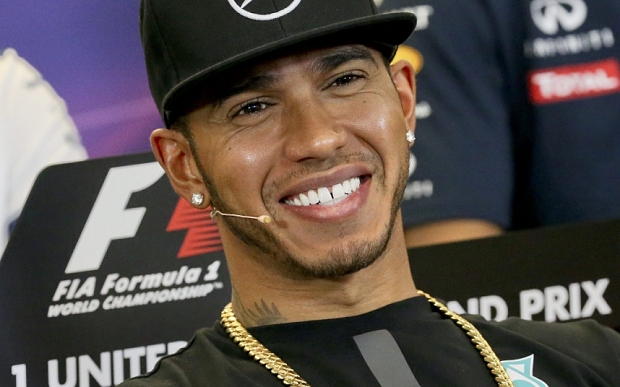



Lewis Hamilton
AND so the pendulum swings again in the 2017 Formula 1 season.
Two weeks after Ferrari’s Sebastian Vettel delivered a hammer blow to Lewis Hamilton in Monaco, Hamilton clawed back much of the lost ground with a perfect weekend in Montreal.
On a track on which he has always excelled, Hamilton was untouchable. “I definitely think I have been at my best this weekend,” he said. You can say that again, Lewis.
Hamilton equalled his hero Ayrton Senna’s mark of 65 pole positions on Saturday, appropriately enough with one of the best laps of his career. And on Sunday delivered a copybook drive for his sixth victory in 10 years at the picturesque Circuit Gilles Villeneuve in one of his favourite cities.
It cut his deficit to Vettel in the championship from 25 points after Monaco – almost a clear win – to 12, a much more manageable and less imposing gap.

The win was founded on what Mercedes F1 team boss Toto Wolff described as a “stellar” qualifying lap.
Hamilton, team-mate Valtteri Bottas and Ferrari drivers Sebastian Vettel and Kimi Raikkonen had looked closely matched until the final part of qualifying. But then Hamilton produced a lap that was nearly a second faster than anything he had managed before.
Vettel got close to within 0.007secs of it, only for Hamilton to move the goalposts again and take pole by 0.33 seconds.
On a day when he was presented with a replica Senna helmet by the late Brazilian’s family as a gift for matching his achievements, and told he would be receiving a genuine one at a later date, it was an appropriately Senna-esque performance.
“I would like to think so,” Hamilton said. “Senna-esque; I hope now I have earned Hamilton-esque.”
If that sounds like braggadocio, it isn’t. It is simply a reflection of a man whose speed on one lap is undoubtedly comparable with his idol’s, even if few would say that as a complete package as a grand prix driver, Hamilton is quite on Senna’s level.

If that sounds like hyperbole, don’t listen to me, listen to Paddy Lowe, the former Mercedes technical boss who has worked with both men during his career.
“Stating the obvious,” Lowe said on Saturday evening in Montreal, “they both sit within the one handful of greats that there are in the history of the sport.”
Has Hamilton got Senna’s speed, I asked Lowe?
“Yeah, undoubtedly,” he said. “Those great drivers are able to pull out an extraordinary lap. You kind of saw that with Lewis today. Probably on Mercedes’ estimations and all their simulations, that time wasn’t in the car. They didn’t have it on their charts for today. They probably thought Ferrari had them after P3 and then Lewis will go out there and really dig deep.
“They can’t do it every Saturday but every now and again they just go out there and something really extraordinary is required and they produce a lap where you go: ‘Wow, where on earth did that come from?’ And Lewis is certainly one to do that, and so was Ayrton.”

Hamilton’s victory was in the bag, barring technical problems, once he had converted his pole into a lead at the first corner and Vettel’s front wing had been damaged as Red Bull’s Max Verstappen came around his outside into second place.
It will forever be an unknown how the race would have panned out had Vettel made it into the first corner behind Hamilton, but Wolff said he suspected Mercedes had too much for Ferrari on this day.
“I think we had a very good car today, a solid car,” he said. “Sebastian was unfortunate to be shaved by Max. We were good in pace today even with the Ferraris in the race. You heard they were struggling for grip and had a temperature problem. If you run in traffic, the magnitude of the problems is multiplied.”
Vettel said: “The pace was there. Bit difficult to read. Mercedes were very strong in the race but it is also a different story when you can control the race and the pace.”

How had Mercedes turned this around after a dismal weekend in Monaco, where they were struggling for pace from second practice?
The answer was a lot of hard work. A group was set up to analyse what had gone wrong in Monaco, and the result was a revision of the way they approached the management of the car over the race weekend.
“At any time of the day or night, when you were in the factory there was light, people were working,” Wolff said. “We ran the simulator 24/7 for 10 days in a row. Nobody took a weekend off in that group and there are no silver bullets in the sport. It is just about analysing the data and trying to make conclusions.
“We looked at all areas. There was no stone left unturned. It was aero, mechanical balance, set-up work, the tyres themselves, the way the drivers drove the car.”
The Mercedes has been a tricky car to work with so far this year, but in Canada at least the team were on top of it. It remains to be seen whether that continues to be the case.
If the team were below par in Monaco, the same could be said of Hamilton, and he drove in Canada as if he had a point to prove. After the race, he implied he felt the same way about the next race in Azerbaijan, where last year he was blisteringly quick but wrecked his weekend with an error-strewn performance in qualifying that ended with a crash.
“Last year in Baku I was very quick,” Hamilton said. “I just had a lapse of concentration and it really threw the whole weekend off. We are going there to try and deliver what we have done this weekend.”

While Hamilton romped to victory, his old rival Fernando Alonso had a predictable return to Formula 1 from his adventure at the Indianapolis 500.
Alonso drove strongly all weekend, and taking into account the power deficit between the Honda and Mercedes engines, his lap in second qualifying was actually quicker than Hamilton’s. That is what he was referring to when he described the McLaren chassis on Saturday as “very competitive” in Montreal.
The race was always going to be difficult on such a power-dependent circuit with an engine that is lacking between 90-100bhp compared to the Mercedes, but Alonso was on course to score McLaren’s first point of the year until he retired with two laps to go. The reason? You guessed it. Another Honda engine failure.
As Alonso pointed out, the retirement not only meant a lost point, it also guaranteed that Alonso will start the Baku race from the back as a result of penalties for using too many engines.
The engine Alonso was using in Canada was the new one fitted to the car when Jenson Button stood in for the Spaniard in Monaco, where he, too, started from the back because the car had already exceeded the permitted number of engine parts.
Asked how frustrated he was, Alonso said: “Well, definitely a lot.” And the same goes for the whole of McLaren.
It became clear early during the Canada weekend that the end of the road is nigh for McLaren and Honda.
While racing director Eric Boullier was insisting publicly that he saw a future for the partnership, saying he “hoped” the partnership was together next year, and that such a scenario was “definitely” realistic, that was just PR spin. And after the race, Boullier described Alonso’s retirement as “yet another gut-wrenching failure”, adding: “It’s simply, and absolutely, not good enough.”
Behind the scenes, several sources say, McLaren are preparing to split with Honda and use Mercedes customer engines next year.
How – and indeed whether – that happens is still not completely certain. No deal has been done for Mercedes, and the mechanics of any split with Honda have not yet been worked out.

Ideally, McLaren would like to take a pause, use Mercedes engines for a while, and revive the Honda partnership when the Japanese engine is competitive. If that is not possible, a divorce is on the cards, although again the details of how that would happen remain unclear.
As things stand, though, the likeliest scenario is that McLaren will use Mercedes engines in 2018, which will provide a competitive boost.
McLaren have reached this point because they have lost confidence that Honda will ever deliver – a message made pretty clear in an interview executive director Zak Brown gave last week, the essence of which he repeated in Canada.
As it happens, a split with Honda is also the only possible way they might be able to keep Alonso next year. He will definitely not stay if the team stick with Honda. But a customer Mercedes engine in a car that is one of the best in the field would be an appealing prospect, certainly more so than a Renault team that is not yet ready to satisfy Alonso’s ambitions.
Alonso would have to take a pay cut from his current $40m salary to stay, because splitting with Honda has a significant financial impact on McLaren. But he does not have a lot of options.
Renault, although interested, would not pay him that. Mercedes will almost certainly stick wth Valtteri Bottas alongside the under-contract Hamilton. Red Bull’s drivers are both under contract in 2018 and, although some are claiming Ferrari might be interested in having Alonso back, Vettel is considered almost certain to extend his stay, and a partnership with Alonso is unlikely in the extreme.
Still, if the Mercedes deal can be secured, and as long as McLaren don’t make a mess of next year’s car, Alonso in a McLaren-Mercedes would likely be a contender for podiums in 2018 and add an intriguing new ingredient into the battle at the front of the field. www.bbc.com